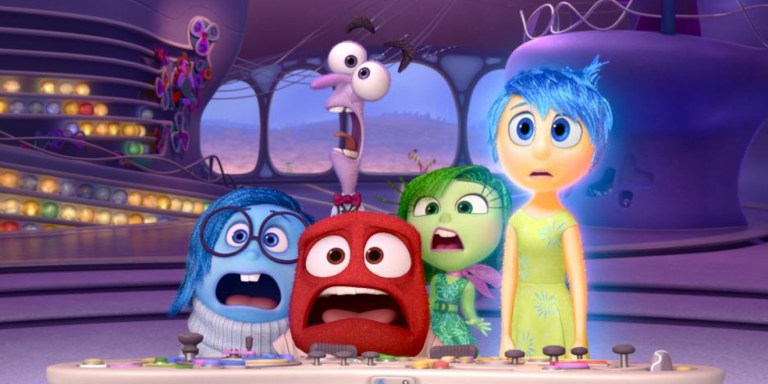“Cars 2,” “Brave,” “Monsters University”: Ever since the release of the simply exceptional “Toy Story 3,” the once-great Pixar has suffered from a particularly resilient strain of mediocrity and pedestrianism. Fortunately for the Silicon Valley based studio, “Inside Out,” the latest creation from Pixar-virtuoso Peter Docter, marks a no-holds-barred return to form. Though hindered by some hackneyed and seemingly sexist plotting, this fun-for-the-whole-family flick about the emotions within a young girl’s head proves to be both a witty and delightfully profound addition to Pixar’s illustrious canon. Rest assured, “Inside Out” is precisely what the Docter ordered.
Based on Pete Docter’s own pre-teen daughter, the protagonist of “Inside Out,” Riley (Kaitlyn Dias) is not too pleased about her family’s relocation to San Francisco (where the broccoli goes on the pizza). Longing for her old friends and her old life, Riley struggles to keep her head above the water amid a sea of overwhelming experiences and altogether foreign feelings. And, though she endeavors to remain positive, Riley’s resolve fades until she surrenders to the dual temptations of sadness and resentment. Riley then begins to isolate herself from her family, leading to an escape that takes her to the local Greyhound station (the eye-roll-inducing on-screen refuge of many a wayward youth).
Stale, cliché, simple: Riley’s arc has little to offer in terms of Pixar’s patented ingenuity. Dad (Kyle MacLachlan) makes Kid move to new city. Mom (Diane Lane) says Kid must support Dad. Kid struggles in school. Dad works too much. Kid runs away. There’s simply nothing in Riley’s narrative that hasn’t been done before.
Moreover, there’s also something vaguely antiquated about the simplicity of Riley’s family dynamic. Dad is the breadwinner? Mom is the doting wife? It’s all a bit 1950s. With “Inside Out,” Pixar’s veiled conservatism is on full display. Early on, for instance, there’s one irksome scene (used repeatedly in the film’s marketing) that serves as both a fantastic set piece and a crippling reminder of Pixar’s inability to break from conventional understandings of gender and sexuality: Riley acts up at the dinner table while Dad thinks about sports and Mom attempts to get Dad to be a good parent (while secretly wishing that she had chosen to marry some hairy Brazilian helicopter pilot with whom all the female characters in this movie are apparently obsessed). It’s not overt but it’s disappointing nonetheless. How come Pixar can seamlessly perfect cinematic narrative but they can’t seem to wrap their heads around characters and families that don’t conform to patriarchal, heteronormative value systems?
Fortunately for “Inside Out,” these tired stereotypes only make up about a quarter of the finished product. Underneath these exchanges is a story rife with meaning: As Riley struggles to adjust to her new surroundings, Docter and company take us inside Riley’s head, showing us the emotions behind her actions. When the going gets tough, these pixie-like sentiments — Joy (Amy Poehler), Sadness (Phyllis Smith), Anger (Lewis Black), Fear (Bill Hader) and Disgust (Mindy Kaling) — jockey for control in “headquarters,” an effervescent situation room situated somewhere in Riley’s brain. Things get tricky, however, when Joy (Riley’s favorite since birth) is dumped into distant long-term memory storage alongside the curmudgeonly Sadness, leaving the pair to work together to return to headquarters before Riley completely loses her mind. On the way, they’re joined by the delightful Bing Bong — Riley’s now-exiled imaginary friend — and, as has become the Pixar standard, a cast of other assorted and colorful characters (Richard Kind).
This little plot inside a plot is easily one of Pixar’s most enjoyable inventions. With all the emotional heft of the studio’s finest, the adventures of Joy and Sadness is both an endlessly imaginative exercise in creativity and a sincere and heartfelt reminder that there is absolutely nothing wrong with feeling down sometimes. In a world wherein the mere discussion of mental illness is avoided at all costs, “Inside Out” is a refreshing embrace of the things (no matter how bleak) that make us, us. Yes, it takes a little while for this tidy tale to find its stride, but once it does, the film manages to hit all the character beats of the three-film “Toy Story” trilogy in a succinct, lean and perfectly choreographed 90-minute run time, while simultaneously crafting a message that is oh-so important.
It also doesn’t hurt that Riley’s emotions are brought to life by a dream ensemble of A-list actors. As Joy, Poehler is fantastic (as always), bouncing around with a certain electricity and gung-ho resolve that is truly infectious and utterly irresistible. The real scene-stealer, however, is Smith who, as the perpetual-downer Sadness, proves both a much-needed foil to Poehler’s positivity, and the origin of the film’s emotional (pun intended) heft. In addition to Poehler and Smith, the rest of the cast is also quite good. Bill Hader is particularly memorable as the angsty Fear, though Kaling and Black complement the film’s leads and together provide countless scenes of comic relief.
In this respect — and others — “Inside Out” is classic Pixar. Though a bit too palatable to be characterized as groundbreaking, “Inside Out” is, at the very least, a comeback for the animation gurus behind some of this decade’s best family-friendly entertainment.
Contact Will Ferrer at wferrer ‘at’ stanford.edu.
